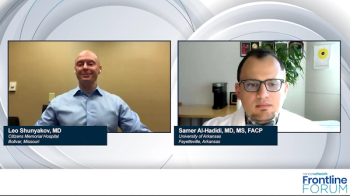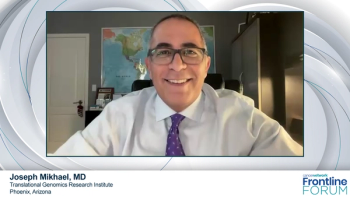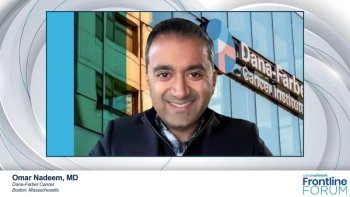
Panelists discuss how they approach treatment strategies and challenges for relapsed/refractory multiple myeloma patients with CNS involvement, sharing case details and preferences among available therapeutic options.

Your AI-Trained Oncology Knowledge Connection!


Panelists discuss how they approach treatment strategies and challenges for relapsed/refractory multiple myeloma patients with CNS involvement, sharing case details and preferences among available therapeutic options.

Panelists discuss how they dose talquetamab in clinical practice, comparing its administration schedule to other bispecific antibodies and addressing dosing-related challenges they encounter.

Panelists discuss how to manage talquetamab-associated adverse events, such as skin toxicities and dysgeusia, sharing their clinical experience with toxicity timing, frequency, and key strategies for fellow oncologists implementing bispecific antibodies in relapsed/refractory multiple myeloma.

Panelist discusses how bispecifics have had a major impact in relapsed/refractory multiple myeloma (R/R MM) because they provide a different way of attacking myeloma, allow oncologists an opportunity to care for patients who cannot have CAR T therapy, and allow oncologist to treat patients who have had an aggressive relapse. The panelist further discusses the importance of bispecifics dosing specifically to maintain a response with the drug but also to prevent the risk of patient infection.

Panelist discusses how every drug oncologists use comes with adverse events (AEs), and with bispecifics they are seeing a similar AE profile to that seen in CAR T-cell therapy. There are 3 major AEs: cytokine release syndrome, neurological toxicity, and infections. To manage AEs, oncologists are now monitoring patients more intensely as well as engaging with the patient’s family to provide updates on the status of the patient.

Panelist discusses the current acceleration of new therapies for multiple myeloma. In the future, oncologists will be able to use CAR T and bispecific therapies more efficiently, and they will also have new tools including new CAR T therapies and bispecifics that will require less manufacturing time, have fewer AEs, and be more effective regarding the targeted disease.

Dr Nadeem discusses his case details and shares his initial thoughts. He then reviews the current treatment landscape for relapsed/refractory multiple myeloma, including his experience with bispecifics in practice and his challenges in using them.

Dr Nadeem discusses his approach to sequencing bispecifics vs chimeric antigen receptor T-cell therapies, including B-cell maturation antigen (BCMA) and non-BCMA bispecifics, and the factors he considers, followed by key takeaways from a recent meeting on bispecifics in relapsed/refractory multiple myeloma, focusing on dosing, adverse event management, and clinical pearls for oncologists.